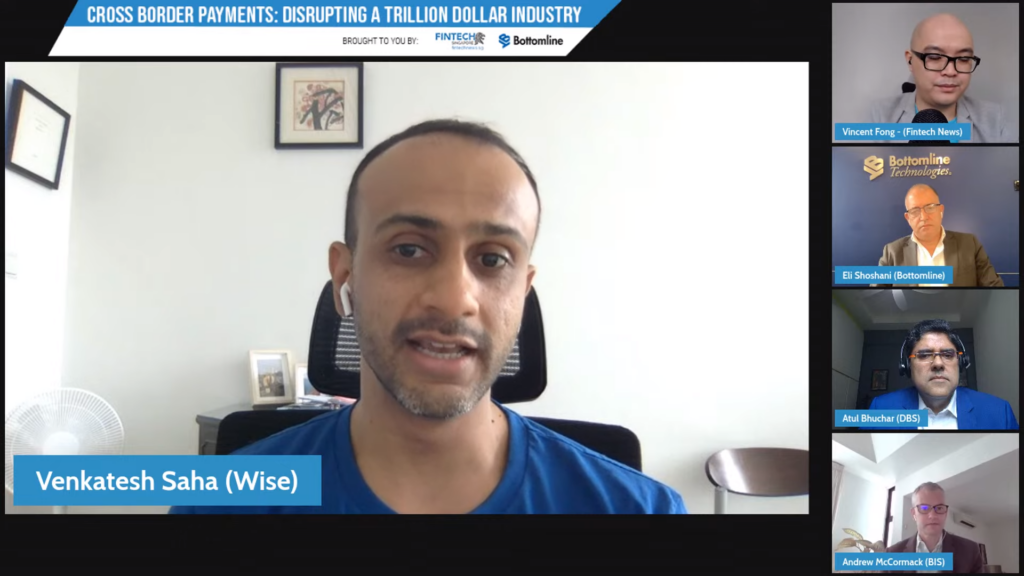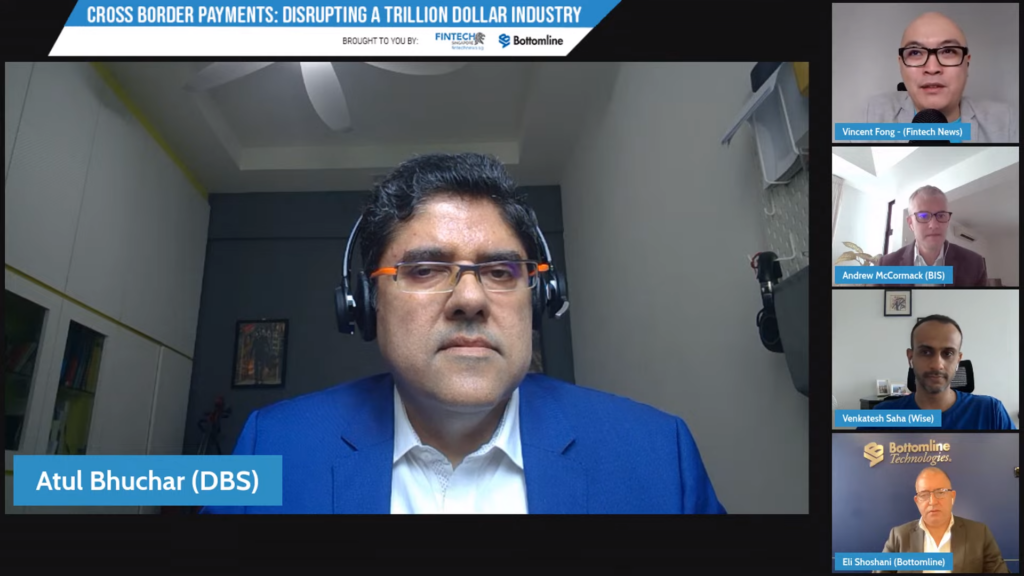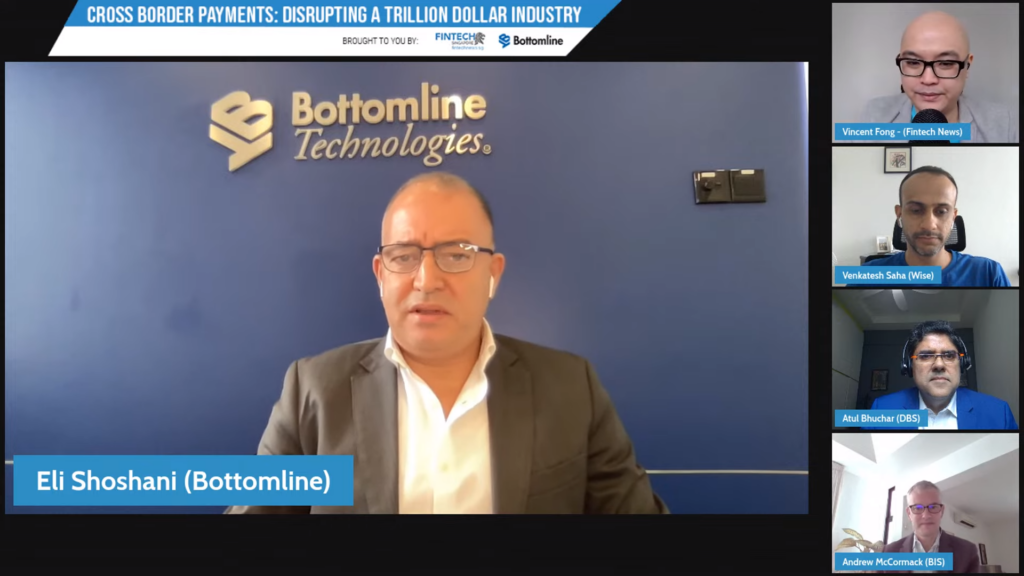
The Trillion Dollar Cross-Border Payments Market is Getting a Makeover
by Fintech News Singapore September 29, 2021The trillion-dollar cross-border payments market is getting a revamp, fueled by technological advances, a changing regulatory landscape and a rush of new entrants promising to solve customers’ long-lasting pain points.
During Fintech Fireside Asia’s latest panel discussion, top executives from the Bank for International Settlements (BIS), DBS Bank, Wise and Bottomline discussed the major trends emerging in the cross-border payments space, the key digitalisation efforts being undertaken, and the challenges that still lie ahead in bringing down costs while improving efficiency.
Drivers behind the disruption of cross-border payments
Andrew McCormack, the Centre Head of the BIS Innovation Hub in Singapore, said that cross-border payments are undergoing a renaissance moment, fueled by increased investment in digital disruption, the entrance of fintechs into the space, efforts from incumbent banks themselves, and the introduction of instant payment infrastructures by governments.
Infrastructures such as Fast And Secure Transfers (FAST) in Singapore and Faster Payments Services (FPS) in the UK have allowed new players like Wise to plug themselves directly and indirectly into these systems and pursue their work in providing more efficient and cheaper cross-border payment services, said Venkatesh Saha, Head of Asia Pacific (APAC) Expansion at Wise.

Venkatesh Saha
“When consumers get used to these levels of services at competitive price levels, I think that begins to set certain expectations for what they expect to see across all things they do online,” Venkatesh said.
“Our view today is to build on the existing payment infrastructures out there and make cross-border more efficient and faster, and continue to lower the cost and improve customer experience … We have an aggressive plan for the other [fast] payment systems.”
Atul Bhuchar, Group Payments Head of DBS Bank’s Global Transaction Services, said that payments are no longer “the plumbing of the global commerce market,” but have instead become a builder of competitive advantage for business clients to differentiate themselves from their competitors.

Atul Bhuchar
This is particularly relevant today with the boom of e-commerce, which continues to act as one of the biggest drivers of cross-border payments, said Eli Shoshani, Head of Asia Pacific at Bottomline,which delivers a payments and messaging platform for accelerating speed-to-market with greater security and lower
costs.
During the session, Atul brought up the “3i” trend in payments – “instant, intelligent and integrated payments” – which has been driving the sector and acted as the cornerstone of DBS Bank’s payment strategy.
The “instant” element has been executed over the past few years and has taken the forms of real-time, 24/7 payments networks and infrastructures, but also includes standardised QR code payments, and proxy addresses, which allow payments to be routed using a mobile phone number or national identity number.
“Intelligent” refers to moving from the purely transactional nature of payments to providing tailored advisory services. Finally, “integrated” relates to the changing market dynamics and evolving customer experiences that are calling for frictionless customer journeys, and thus requiring payments to be embedded into larger ecosystems and platforms.
Fragmentation and regulation remain as key challenges
Despite significant strides and the introduction of real-time payments infrastructures, the speakers noted that modernisation efforts have been fragmented and largely localised, bringing in the need for interconnectivity between these different systems to truly help improve cross-border payments.
“When you are moving from local fast payments to cross-border fast payments, you need to take into the challenges into consideration,” Eli said. “For us, as a service provider, this is the area where we are focusing: how do we connect the gateways? How do we connect fast payments locally into cross-border payments globally?”

Eli Shoshani
Echoing Eli, Andrew named fragmentation as one of the key challenges for the sector, noting that numerous systems exist and use different message formats. “Some sort of coordination around message formats as well as the ability to move between one ecosystem to another, would be a key [enabler],” he said.
For young ventures and new entrants like Wise, Venkatesh said that although the regulatory landscape has matured and allowed for a new generation of services providers to emerge and offer innovative, more efficient and cheaper cross-border payments, there is still space for improvement.
“[In APAC,] unlike in Europe where a single license permits us to passport our services to nearly 30 countries overnight, here, the only reason why I can’t expand faster is that I have to be independently licensed in every jurisdiction that I go to,” Venkatesh explained.
“Often to offer the entire range of services in some markets, I need two, three, four different licenses, and in some markets, I can only apply for one license after the other. That’s why it takes some time, often more than two years to launch. It’s a significant investment for any player that wants to do [cross-border payments].”
Key cross-border payments’ modernisation initiatives
At the BIS Innovation Hub Center in Singapore, the team has been advancing cross-border payments innovation through two main projects: Project Nexus, which focuses on connecting existing national instant payment infrastructures; and Project Dunbar, which focuses on cross-border payments using central bank digital currencies (CBDCs).

Andrew McCormack
“Project Nexus is our blueprint and vision … for interconnecting instant, real-time payment infrastructures, that now exist in 60 countries and counting,” Andrew said.
“We wanted to come up with a base protocol vision for how instant payment infrastructures could potentially be connected. We’ve finished the first phase and they’re now looking to go into a prototype phase with some new partners. That’s coming up in the next months or so.”
Project Dunbar, unveiled earlier this month, is a partnership between the BIS Innovation Hub, the Reserve Bank of Australia, Bank Negara Malaysia, the Monetary Authority of Singapore (MAS) and the South African Reserve Bank, and focuses on testing the use of CBDCs for international settlements.
“We are grateful for the participation of these central banks because they’ve all done, for many years, a lot of research in the CBDC space,” Andrew said. “The role of BIS is to bring all those different perspectives and markets together,” he further added that they are very excited about what CBDCs could bring to the table.
Around the world, central banks have been a catalyst for CBDC innovation, Atul said, noting that the pace of development has been “phenomenal”.
In Singapore, MAS started looking into the potential of blockchain and distributed ledger technology (DLT) in 2016 through the launch of Project Ubin. This ultimately culminated in the setup of Partior, a partnership between DBS Bank, JP Morgan and state investment firm Temasek, that seeks to develop an open industry platform for interbank value movements.
“What [Partior] does is to leverage on the native strength of the blockchain – programmability with smart contracts, traceability, instant and atomic settlements, [greater] efficiency as the number of hubs are reduced, more predictability in terms of costs, and costs savings – … and make money movement, intelligent, faster, cheaper, and more efficient,” Atul explained.
“This would introduce multi-currency clearing [as the first step]. The next step would be cross-border payments, [followed by] conditional payments and more. [There are also] use cases in FX, trade, etc. [The Partior platform] is targeted to go live this year … It’s an exciting space.”
The full webinar can be viewed below, if you enjoyed this content please consider subscribing to our YouTube Channel.







